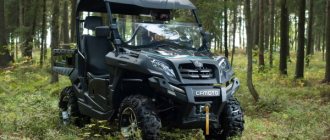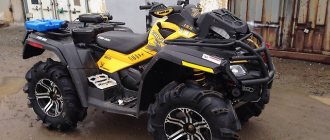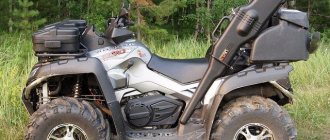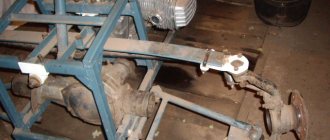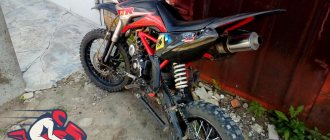Motorcycles are popular not only among athletes, but also among outdoor enthusiasts, fishermen, hunters, and tourists. There is no need to delve into the reasons - ATVs and pit bikes have good cross-country ability, are durable, and are able to navigate difficult terrain. Light weight and excellent maneuverability ensure easy operation and minimize the risk of injury in case of a fall. But what is better - an ATV or a pit bike? Here's a checklist of five sequential steps to help you make your decision.
First step: appointment
Any equipment is purchased for a purpose, and what you ultimately acquire depends on the purpose. If you need a device for fun country rides, extreme sports, maybe even for ski jumping, choose a motorcycle. A fast, playful, maneuverable, lightweight pit bike will be an excellent choice and is guaranteed to provide an adrenaline rush.
If your goal is fishing, hunting, or long-term tourism, you should take an ATV. A four-wheeler will not give you high speed, but it will provide the ability to transport significant cargo, for example, fishing or hunting gear, a tent, and other camping supplies. In addition, long trips are much more comfortable on a wide, comfortable ATV seat than on a narrow pit bike seat.
Technical differences between a pit bike and a motorcycle
We will compare pit bikes of several BSE and Kayo models, and the classic city motorcycle CFMOTO 250 NK (ABS).
Dimensions
The first thing that catches your eye is the size: pit bikes are much smaller. On average the dimensions are:
| Parameter | 125 cc pit bikes | 250 cc pit bikes | CFMOTO 250 NK (ABS) |
| Length, cm | 155-170 | 185-210 | 199 |
| Handlebar width, cm | 75-80 | 75-80 | 78 |
| Height, cm | 80-100 | 95-110 | 107 |
| Wheelbase, cm | 110-120 | 130-150 | 136 |
| Weight, kg | 65-80 | 110-115 | 151 |
| Ground clearance, cm | 20-22 | 25-28 | 15 |
As you can see, even powerful 250 cc pit bikes, almost comparable in size to a compact motorcycle, weigh less and have much greater ground clearance. Well, the more common pit bikes with engines of 125-150 cc will differ in size.
Among other important things: low weight is a plus for “mud” transport. Even if you get stuck, you can easily pull it out even alone. And its small dimensions simplify transportation - to get to the track, a pit bike with the wheel removed can even fit into the trunk of a crossover, station wagon or large hatchback with the rear seats folded down.
Engine, power, speed
Children's and teenage pit bikes usually have 50-100 cc engines with a power of about 2-3 “horses”. For 125 and 150 cc models, the power is usually 8-15 hp, which is enough to accelerate to 90-100 km/h on a straight, flat road. And the most powerful 250 cc engines can produce 17-21 hp.
For comparison: a 250 cc motorcycle has an average power of about 25-30 hp, and a 125 cc motorcycle has about 12-15.
Among other “engine” nuances, pit bikes usually have a muffler with a large exhaust hole diameter. It sounds very loud when revving up.
Controllability
In terms of handling, a pit bike is something between a motorcycle and a bicycle, but there are a couple of features:
- Weight and size. Due to the small dimensions and weight, the rider has to work much more actively with his legs and body: lean back and forth and to the sides more often and more strongly, and hold the seat more firmly with his hips. And the low seat height allows you to move your feet, which can be useful for quick turns, or for carefully passing a particularly difficult section.
- Power. Since pit bikes have approximately the same (or slightly less) number of “horses”, but at the same time weigh 1.5-3 times less than motorcycles, they take off and accelerate much faster.
What is the result: a pit bike steers more sensitively and reacts to steering wheel turns much sharper than motorcycles and scooters.
Wheels
Pit bikes have small wheels - their diameter can be from 12 to 18 inches in the rear and from 14 to 21 inches in the front. Typically, classic pit bikes (without a cross bias) have wheels with a diameter of up to 14/17 inches.
This is done in favor of cross-country ability and dynamics: small wheels weigh less and also allow you to accelerate much faster.
Suspension
Since pit bikes are designed for jumps, jumps, and simply off-road with holes and bumps, they have increased suspension travel: usually 25-30 cm. The suspension itself is also simple: a monoshock absorber at the rear, an inverted fork at the front. They react very sensitively to impacts in order to absorb them upon landing.
Starter
Often, especially in budget models, a kickstarter is installed instead of an electric starter. This not only makes the pit bike cheaper, but also makes it lighter - since you can do without a battery.
Second step: speed indicators
We have already noted that ATVs are not as fast as motorcycles. This is logical - pit bikes weigh less, have higher dynamic performance, and less resistance to oncoming air flow. It will not be difficult to accelerate them in a straight line in a few seconds. But the question is: is this speed important in off-road conditions? If you are an athlete - of course, if you are a tourist or amateur - not especially.
ATVs are slower. Typically, the speed of utilitarian vehicles does not exceed 70-90 km/h. But they are not designed for racing, their main task is to overcome off-road conditions and pull loads, and quads do this job perfectly well. By the way, sports models of four-wheelers are also quite fast - they can drive 130 km/h, but they are not suitable for off-road use.
So, if speed is important to you, choose a pit bike; if practicality comes first, choose an ATV.
Disadvantages of ATVs
The main disadvantage is their cost. This is a fairly expensive hobby if you consider the ATV only as a means of entertainment. The average cost is 150-250 thousand. Simpler models can be purchased for 70-80 thousand. However, there are options, the price of which reaches up to 1 million rubles. The engine capacity is more than 900 cm³, and the speed is over 90 km/h.
The second is the low level of security. Therefore, when driving a vehicle, especially a powerful one, it is necessary to have motorcycle protection. Beginners often roll over on sand and gravel. Children and teenagers can operate the all-terrain vehicle only under adult supervision.
Another significant drawback is high fuel consumption. Almost 10 liters of gasoline are consumed per 10 km of travel. Such consumption will not surprise the car owner, but it will make the owner of light motorcycles think. The weight, dimensions and technical characteristics of these vehicles are different. Everything is explained simply - the special design of the ATV engine is “tailored” for off-road driving.
The ATV has quite a high fuel consumption
The functionality of all-terrain vehicles is also not that high. To transport large cargo you will have to purchase a trailer. And these are additional costs.
The last thing worth mentioning is the lack of protection from changing weather conditions. The ATV is not equipped with a roof or protective glass, so it is inconvenient to ride it in rain and strong winds.
And lastly, to drive you need to obtain a category A driver's license.
Third step: permeability
When choosing between a quad and a motorcycle, you need to take into account the operating conditions in which the equipment will find itself. If you plan to ride over rough terrain and on public roads, you should take a motorcycle with a title. It will allow you not only to plow through suburban landscapes without problems, but also to navigate city traffic, avoiding traffic jams and shortening the road through narrow streets. Such tricks will not work with a quad.
But if your goal is to operate exclusively in severe off-road conditions, an ATV would be a more preferable option. Four wheels are definitely more stable than two. And where you can easily fall off a motorcycle, the quad will carry you without any problems. A pit bike, of course, is capable of withstanding off-road conditions; after all, it was created for these purposes, but long rides are not its element. In this case, the ATV will provide reliability and good cross-country ability.
Conclusion
So, we have listed the main features of these two types of equipment. It is very difficult to say unequivocally what is better: an all-terrain vehicle or an enduro. When choosing between these two types, it is worth taking into account the above factors and, of course, your own opinion, which should be the main selection criterion.
Four-wheel drive ATV with winch
Fourth step: comfort, safety
Interestingly, in terms of safety, motorcycles and ATVs are not particularly different. Of course, quads are more stable, but they can also turn over, especially if they are not used correctly. But if you can get out from under a light pit bike without much difficulty on your own, then it will be difficult to get out from under an overturned quad bike without outside help, especially if trouble happens to an inexperienced rider. There is a chance of injury in both the first and second cases, but the large weight of the ATV can cause more serious injuries.
In terms of comfort, motorcycles are, of course, inferior to four-wheelers. The rider does not need to constantly strain and maintain balance. Naturally, particularly difficult sections will need to be ridden in a standing position, but otherwise the ride will be much more comfortable than on the pit. Of course, we are not talking about budget models with “wooden” shock absorbers: they will provide no more convenience than a two-wheeled vehicle. But advanced configurations allow you to travel with maximum comfort. In addition, quadrics can easily carry two riders and additional cargo in addition, a motorcycle cannot boast of this.
Fifth step: price, versatility, efficiency
An ATV is a workhorse that can perform many functions: fishing trips, hunting, tourism, entertainment, solving household and household problems. The motorcycle has a slightly different purpose. It can be used at motocross competitions, for amateur riding in the countryside, as a means of moving around the city, and for tourism. You cannot carry additional cargo on it. You can, of course, get creative, but this will negatively affect the controllability of the equipment.
With efficiency, everything is not so clear. If there are no questions about motorcycles - they consume fuel economically, but at the same time do not lose power and maneuverability, then with quadrics the situation is a little different. Some models can consume only 2.5-3 liters of gasoline per 100 km, but at the same time they significantly lose cross-country ability. More powerful utilities consume an average of 9-12 liters per 100 km.
The prices for ATVs and motorcycles are not particularly different. Both of them have both basic versions, the cost of which is in the range of 50-60 thousand rubles, and models with extended configurations, the cost of which can reach 200-300 thousand rubles. If we continue the conversation about premium technology, the figure will grow exponentially.
Disadvantages of pit bikes
However, the disadvantages of mini motorcycles cannot be ignored. Before purchasing, consider the following nuances:
- Engine cooling is air-oil. This means that the engine overheats faster, and dirt collected during off-road driving quickly “sticks” to the engine housing.
- Liquid mud is not the best type of road surface for a pit bike. To prevent it from clogging the engine, you need to take care of its protection.
- With constant vibration, some of the bolts may become unscrewed, so all connections must be checked and tightened regularly.
- Pit bikes have a number of restrictions on cross-country ability. Liquid mud, loose snow, snowdrifts - all this is not the best option for a mini-motorcycle.
- There is a need for frequent oil changes. On average, this procedure is carried out every 20 engine hours.
- Pit bikes can hardly be called quiet, so those around you are not always enthusiastic about such hobbies.
A pit bike is not as passable as an ATV
Beginners should remember that a pit bike has a rather short wheelbase and at the same time a high-spirited engine. Therefore, when riding a mini-motorcycle for the first time, you need to be extremely careful.
What's the result?
Any technology can have both pros and cons. There are no unambiguously good or unambiguously bad options; here, for the most part, everything depends on the operating conditions and the purpose of purchasing the device.
Briefly about the advantages
| ATVs | Motorcycles |
| High stability, rider comfort while driving | High speed along with excellent cross-country ability |
| High load capacity – up to 200 kg | Good handling and maneuverability in all conditions |
| Easy to control - no need to balance | Small size and weight - easy to pull out of mud, less chance of injury if you fall |
| Excellent maneuverability | Ability to drive through narrow paths and difficult places |
| Versatility: work, tourism, leisure | Versatility: sports, tourism, recreation, the ability to move around the city (if you have a vehicle) |
What should a beginner pay attention to when buying a motorcycle?
You have chosen what you want to buy - an ATV or a pit bike. But the torment of choice, unfortunately, will not end there. Then you will have to face the need to find that one and only device. What to do if this is your first vehicle from the motorcycle class? We have prepared some tips for beginners to help you make a decision.
- The engine is the heart of any car. The power of the equipment and the speed it can develop depend on its volume. If you have never ridden a bike or quad, discard models with large cubic capacity immediately. It is quite difficult to control them, and without skills it is dangerous. For beginners, a cubic capacity of 125-150 cm³ in the case of ATVs, 125-190 cm³ in the case of pit bikes will be quite enough.
- Equipment. Again, it depends on the purpose of acquiring the equipment. If you plan to just ride around the countryside, there is no point in taking the extended version; most of the functionality will not be used anyway. But if your goal is hunting, fishing, work on the site, training in motorsports disciplines, it is better to take a device with a full range of options and add-ons.
- Dimensions. Motor vehicles must be selected according to the owner’s parameters. Otherwise, not only will the driving quality suffer, but the driver's safety will also be endangered. This applies not only to children or teenagers, but to adults too. It is best to get advice from the salon staff and immediately “try out” several proposed options on the spot to understand which one is more suitable.
Choosing a motorcycle is not an easy task, and the modern variety of models makes it even more difficult. But here, as in a supermarket, the main rule is not to take “extra.” Look for equipment that suits your needs and tastes, then there will be no problems with it.
Types of two-wheeled iron horses
Motorcycles also come in several types. Sports and cross-country models are designed for competitions and fast driving. The most expensive models have the ability to reach speeds of more than 300 km/h.
Classic models are distinguished by their straight fit, comfortable design, and ease of use. The classic is time-tested, it is not very fast. Even inexperienced drivers feel confident on the road in such a vehicle. Choppers are a separate type of bike. An imposing driver's position, aggressive design and an elongated steering wheel are their main characteristics.

